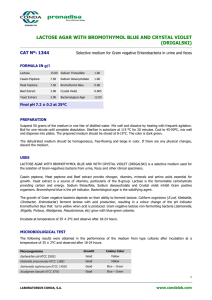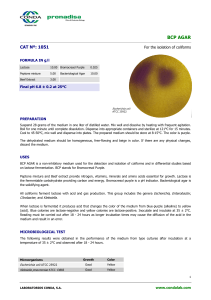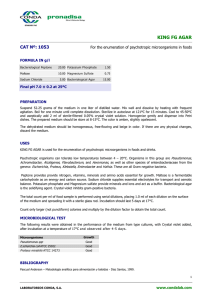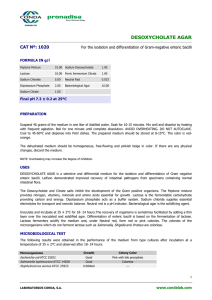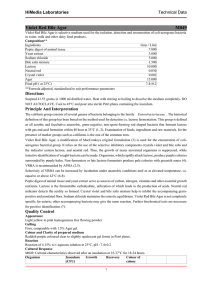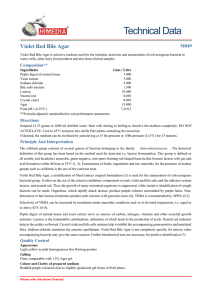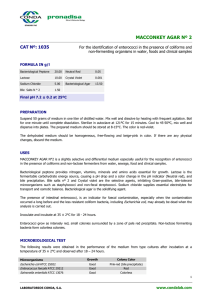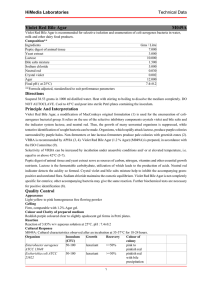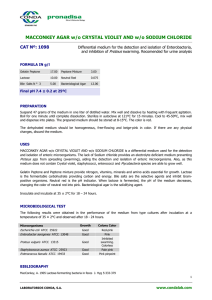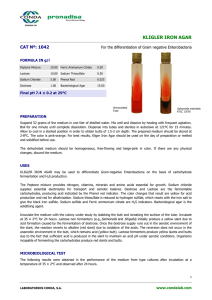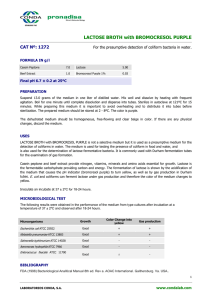VIOLET RED BILE AGAR WITH LACTOSE & GLUCOSE (VRBLG) EUROPEAN PHARMACOPOEIA
advertisement
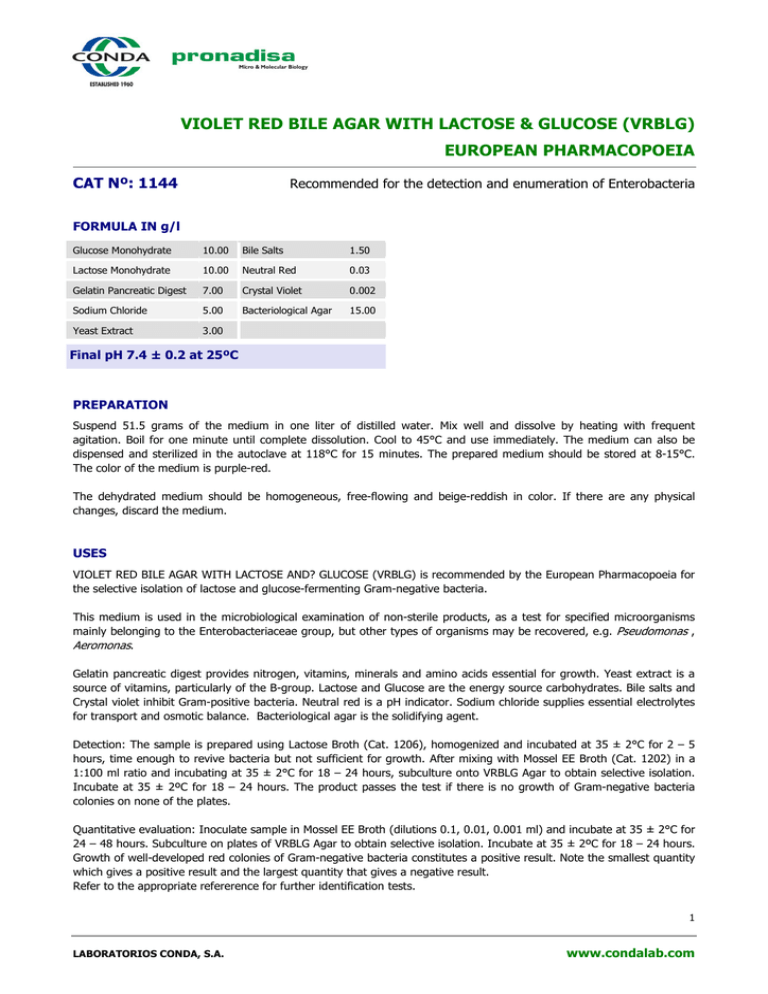
VIOLET RED BILE AGAR WITH LACTOSE & GLUCOSE (VRBLG) EUROPEAN PHARMACOPOEIA CAT Nº: 1144 Recommended for the detection and enumeration of Enterobacteria FORMULA IN g/l Glucose Monohydrate 10.00 Bile Salts 1.50 Lactose Monohydrate 10.00 Neutral Red 0.03 Gelatin Pancreatic Digest 7.00 Crystal Violet 0.002 Sodium Chloride 5.00 Bacteriological Agar 15.00 Yeast Extract 3.00 Final pH 7.4 ± 0.2 at 25ºC PREPARATION Suspend 51.5 grams of the medium in one liter of distilled water. Mix well and dissolve by heating with frequent agitation. Boil for one minute until complete dissolution. Cool to 45°C and use immediately. The medium can also be dispensed and sterilized in the autoclave at 118°C for 15 minutes. The prepared medium should be stored at 8-15°C. The color of the medium is purple-red. The dehydrated medium should be homogeneous, free-flowing and beige-reddish in color. If there are any physical changes, discard the medium. USES VIOLET RED BILE AGAR WITH LACTOSE AND? GLUCOSE (VRBLG) is recommended by the European Pharmacopoeia for the selective isolation of lactose and glucose-fermenting Gram-negative bacteria. This medium is used in the microbiological examination of non-sterile products, as a test for specified microorganisms mainly belonging to the Enterobacteriaceae group, but other types of organisms may be recovered, e.g. Pseudomonas , Aeromonas. Gelatin pancreatic digest provides nitrogen, vitamins, minerals and amino acids essential for growth. Yeast extract is a source of vitamins, particularly of the B-group. Lactose and Glucose are the energy source carbohydrates. Bile salts and Crystal violet inhibit Gram-positive bacteria. Neutral red is a pH indicator. Sodium chloride supplies essential electrolytes for transport and osmotic balance. Bacteriological agar is the solidifying agent. Detection: The sample is prepared using Lactose Broth (Cat. 1206), homogenized and incubated at 35 ± 2°C for 2 – 5 hours, time enough to revive bacteria but not sufficient for growth. After mixing with Mossel EE Broth (Cat. 1202) in a 1:100 ml ratio and incubating at 35 ± 2°C for 18 – 24 hours, subculture onto VRBLG Agar to obtain selective isolation. Incubate at 35 ± 2ºC for 18 – 24 hours. The product passes the test if there is no growth of Gram-negative bacteria colonies on none of the plates. Quantitative evaluation: Inoculate sample in Mossel EE Broth (dilutions 0.1, 0.01, 0.001 ml) and incubate at 35 ± 2°C for 24 – 48 hours. Subculture on plates of VRBLG Agar to obtain selective isolation. Incubate at 35 ± 2ºC for 18 – 24 hours. Growth of well-developed red colonies of Gram-negative bacteria constitutes a positive result. Note the smallest quantity which gives a positive result and the largest quantity that gives a negative result. Refer to the appropriate refererence for further identification tests. 1 LABORATORIOS CONDA, S.A. www.condalab.com MICROBIOLOGICAL TEST The following results were obtained in the performance of the medium from type cultures after incubation at a temperature of 35 ± 2°C and observed after 18-24 hours. Microorganisms Growth Colony Color Escherichia coli ATCC 11775 Salmonella gallinarum NCTC 9240 Staphylococcus aureus ATCC 6538 Shigella flexneri ATCC 29903 Streptococcus lactis ATCC 19435 Good Good Inhibited Good Inhibited Red Red Red BIBLIOGRAPHY European Pharmacopoeia 6.0 Hitchins, A.D., P.A. Hartman, and E.C.D. Todd. 1992. Coliforms – Escherichia coli and its toxins, p. 325-369. In Vanderzant, C., and D.F. Splittstoesser (ed.) Compendium of methods for the microbiological examination of foods, 3rd ed. American Public Health Association, Washington, DC. EP STORAGE 25ºC Once opened keep powdered medium closed to avoid hydration. 2ºC 2 LABORATORIOS CONDA, S.A. www.condalab.com
